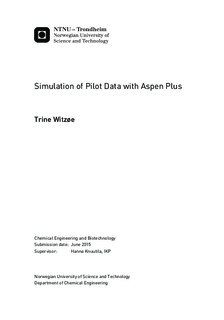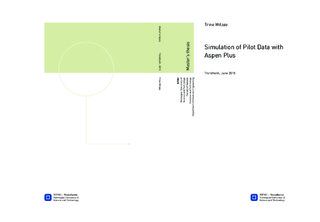| dc.description.abstract | Over the last few decades there has been an increasing interest in climate change and global warming. It is believed that one of the major causes of the enhanced greenhouse effect, that causes global warming, is anthropogenic CO2 emissions. In the work that has been done on reducing anthropogenic CO2 emissions, research into carbon capture and storage is now of considerable importance. Today, one of the most promising near-term mitigating strategies is post-combustion capture and chemical absorption with amine solvents.
The objective of the research described in this thesis has been to develop a robust and reliable simulation model of the chemical absorption capture process with 30wt% MEA. The simulations were performed in Aspen Plus version 8.6, and an inbuilt template, ENRTL-RK_Rate_based_MEA_Model , was used as a basis for the simulation model. The absorber and stripper columns were simulated separately using a rate-based model. Five different pilot campaigns were used in the absorber simulations, and four different pilot campaigns were used in the stripper simulations. The inbuilt template from Aspen Plus was used without any changes in the physicochemical package. However, during the absorber simulations, a kinetic constant from the literature was used to optimize the model performance. Flow rates, composition, temperatures and pressures of the inlet streams were used as inputs in the model, in addition to the reboiler duty in the stripper simulations. Analogous, flow rates, compositions and temperatures of the outlet streams from the simulations were compared with experimental data to verify the model s performance. In the evaluation of the simulation model, the absorption/desorption rate from the simulations was compared with the experimental values.
In total, 103 experimental runs were simulated in the absorber part, and 78 experimental runs were simulated in the desorber part. When the absorber simulation model was modified using the kinetic constant from the literature, the overall average deviation, including all runs, was found to be 9.8% and the absolute average deviation was found to be 8.5%. In addition, the predictions of the temperature profiles were found to be accurate, within a 2 °C deviation from experimental measurements for almost all runs, except in one of the campaigns. The performance of the simulation model was therefore deemed satisfactory in the absorber part. In addition, all campaigns showed similar results, thus indicating consistency.
In the desorber simulations, the performance of the simulation model was somewhat more variable, and several possible causes were examined in order to understand the predictions. The Aspen Plus template without any changes performed better than the modified model using a kinetic constant from the literature, and thus the template was used directly. The performance in three out of the four campaigns was satisfactory. When one outlier was disregarded, the average deviation was found to be below 7.9% and the absolute average deviation was found to be below 7.6% for all three campaigns individually. The overall average deviation and absolute average deviation including all 78 runs was found to be 16.1% and 14.5%. Also for the desorber part, the deviation in the temperature profiles was below 2 °C for almost all runs. There were not found a reason why the predictions in one of the campaigns were poorer than the others. | |

